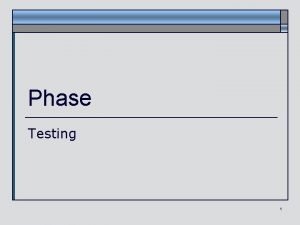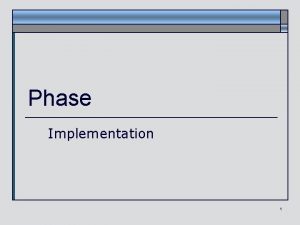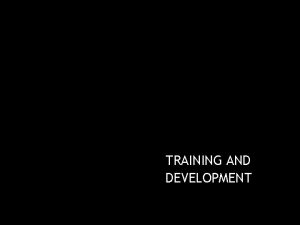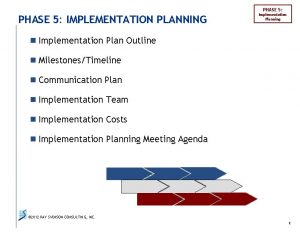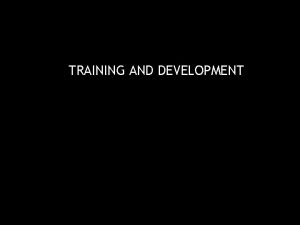ChapterEight Development and Implementation of Training Development Phase








- Slides: 8

Chapter-Eight Development and Implementation of Training Development Phase Input Determine Factors, That Facilitate Learning & Transfer Alternative Instructional Methods Process Instructional Strategy Output Program Development Plan • Instructional material • Instructional Equipment • Trainee and Trainer Manuals • Facilities • Trainer

Development and Implementation of Training TRAINER On-the-job- Trainers: On-the-job (OJT) trainers are different from the traditional trainer. OJT trainers are usually classified as jobholders or supervisors for the jobs for which they are providing training. As a result, there are some unique sues to consider. For OJT programs to be effective, the trainers need to • know the job to be trained, • be knowledgeable in the interpersonal skills necessary to interact effectively with those they train, • be skilled as trainers, and • be motivated to be trainers. OJT in general uses co-workers and supervisors as trainers. None of these people started out to be a trainer, and likely one has formal training in how to be an effective trainer. The OJT trainer does need to know the job to be trained, but the best trainer is not necessarily the person who can best do the job. The OJT trainer should have a solid understanding of how the job is performed an ability to interact effectively with others. But give they did not sign on as trainers, it should not be expected that they would understand specifics related to teaching others how to do the job. To effective, therefore, such training is necessary and should included: • The company’s formal OJT process (i. e. JIT) and the policies and support provided by the organization • Interpersonal skills and feedback techniques, and • Principles of adult learning

Development and Implementation of Training THE CONSULTANT If the training required is not specific to the organization but more generic (e. g. , conflict management, interviewing skills, or computer skills), find a consultant with a trailing package that can be adapted to fit the company’s needs. Using the consultant’s prepackaged program without any alterations would reduce the overall cost. The advantage of prepackaged programs is they are ready to go. The disadvantage is that they are not specific to a company. This trade-off may be more acceptable of a session on conflict resolution than for a session on team development. In fact, many prepackaged programs can be used to supplement a company’s own program. They can be less costly than hiring a consultant, but some are still expensive. Some consolation firms offer prepackaged programs and also provided training for the trainers. This option adds to the cost, but the training is usually quite good. If great deal of training will be taking place in the organization, this option may be worth the extra expense if it is amortized over multiple sessions.

Development and Implementation of Training THE CONSULTANT/Cont. . . In deciding whether to use a consultant, consider questions such as the following: Ø How many employees are to trained, and will they need constant retraining? Ø Can advantages be realized from involving a neutral third party (e. g. , unionmanagement cooperative ventures)? Ø Is there a rush to get the training done? Ø Is there in house expertise? If the decision is to use a consultant, consider the following: ØAsk for references, ask who they have trained, and be sure to follow up on this information (consultants very in their expertise). ØDetermine how much the consultant knows about the industry. ØReview some of the training objectives in consultant’s training packages. ØFind out how the consultant evaluated success in training. ØMake sure you know who will be doing the work. Often you meet the salesperson, not the trainer.

Development and Implementation of Training IMPLEMENTATION Exercises or Game: Several models incorporate excesses into the learning process. One such model is exhibited in following figure. This modification of an earlier model from Pfeiffer and Jones allows trainees to experiences firsthand a process related to the current training, then hear some information about the topic for comparison with what they did. Then they process the new information, generalize in to their situation, and attempt to apply it in their situation and attempt to apply it in a more relevant situation. Let’s examine this process more closely. Step 1: The Experience: The learning experience begins with some sort of activity that ties into the training topic. In this way, all trainees begin by sharing a common experience. This first experience should not be related too closely to the actual work setting. Step 2: The Lecturette: After the experience, the trainer provides information (e. g, concepts and principles) related to topic at hand. This can be a lecture, a video, or some other form. In our example, a lecture would describe how to develop interview questions related to job requirements. Here There the trainers shows how important it is to examine to job determine what is needed, rather than simply making up questions that sound good.

Development and Implementation of Training IMPLEMENTATION/Cont. . Step 3: Processing the Information an Experience After the experience and lecturette trainees work in small groups to discuss their experience based on the information they just received. In our example, he trainer might ask the groups to analyze the questions they developed answer the question “What criteria did we used to develop these questions, ? ” Another question might be, “How are these questions related to the job of scout leader? ” Then each of the small groups could report to the entire group what they discovered about how they developed interview questions. Step 4: Generalize-ability At this point, it is important for the trainees to see how the learning is relevant to situations outside the training. According to Pfeiffer and Jones, the key questing here is “So what? ” The goal is to have trainees consider how this new information fits with the things they do back on the job. From the analysis and learning that took place, trainees should fifer that scout leader interview questions can be developed in a better way and be able to generalize this to other similar situations. Step 5: Practice The trainees receive another task similar in nature to the first so that they can practice the newly found skill. Note that in this step, the task should be more closely related to the actual job. In our example, the trainees could be asked to develop interview questions for selecting someone for a job in the area they mange.

Development and Implementation of Training Experiential Learning Model Experience (the exercise/game) Practice (try it out) Lecturette (provide information} Generalize-ability (relevancy to other situations) Processing (analysis of experience and information)

Development and Implementation of Training TRANSFER OF TRAINING Input Process Output Supervisor and Peer Support Trainer Support Post-Training Self-Efficacy Learned KSAs Proactive Learned KSAs on the job Relapse Prevention and Goal Setting Supportive Climate Alignment of Reward system Valence of Outcomes KSAs Transferred to the job

